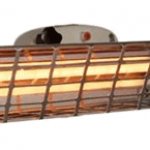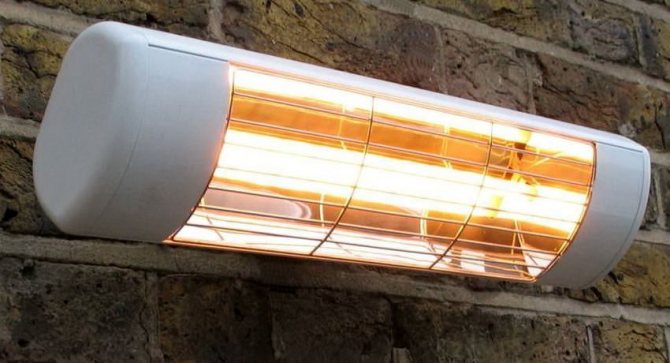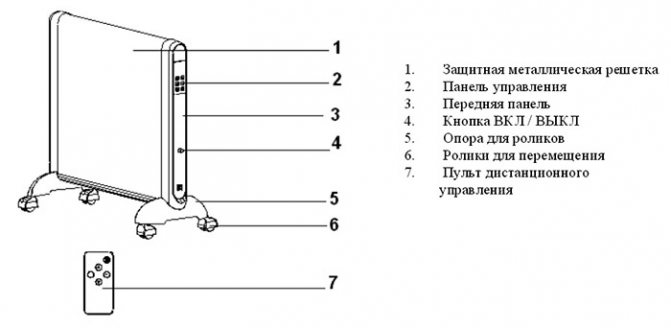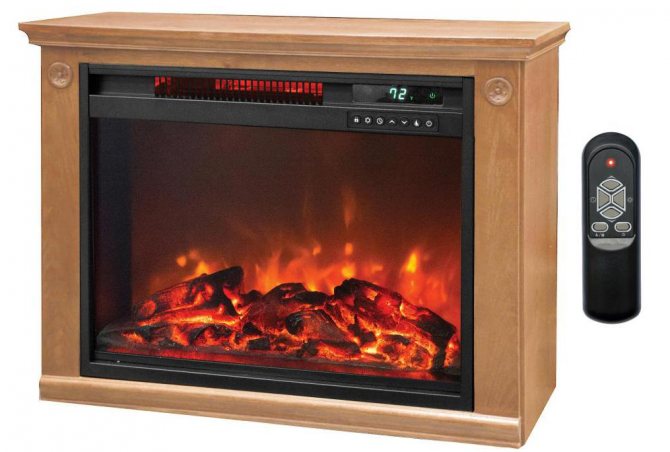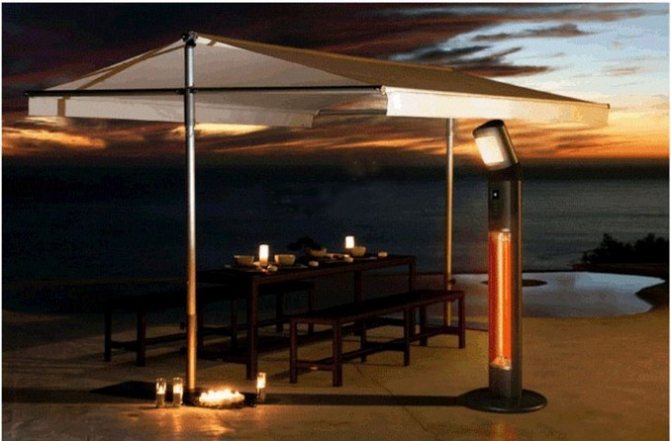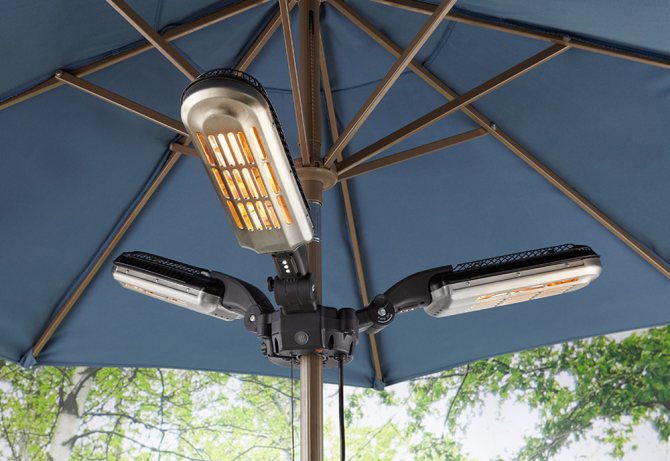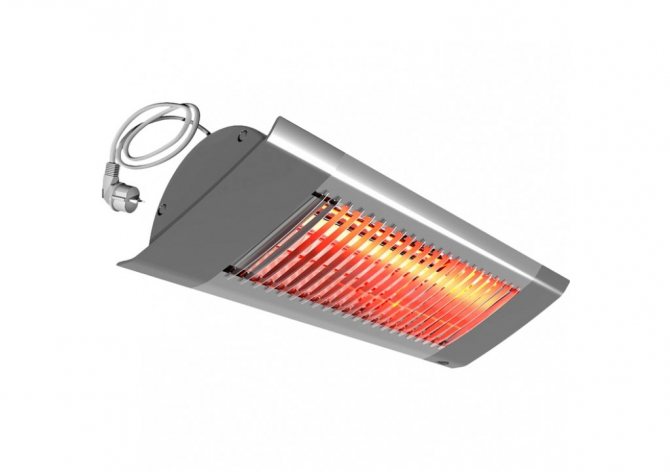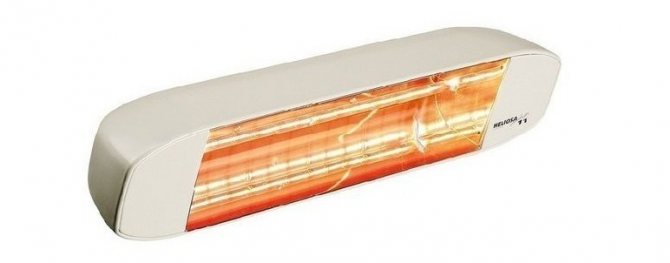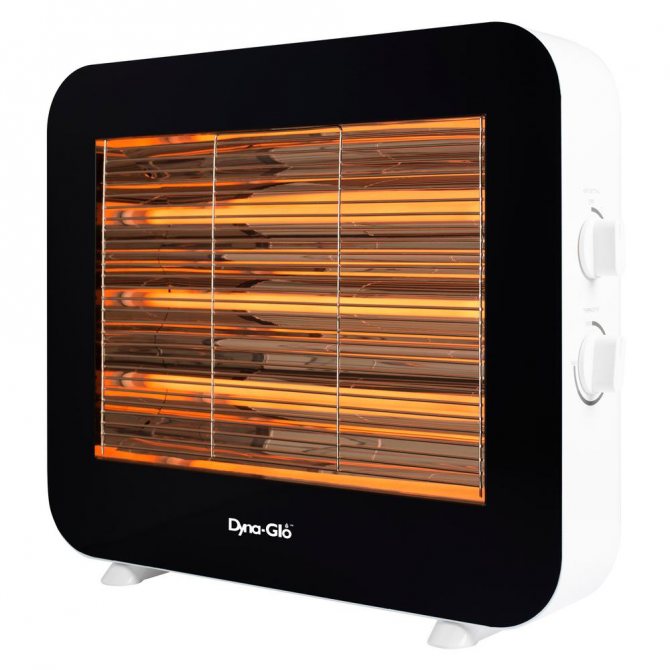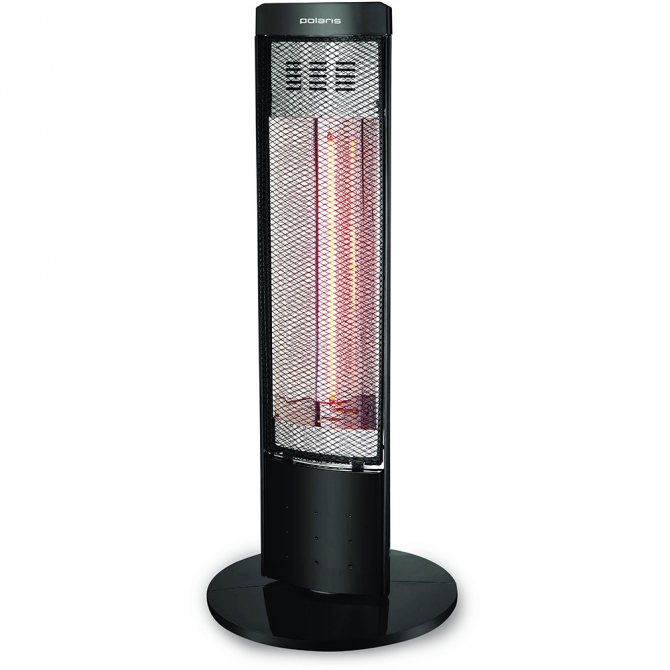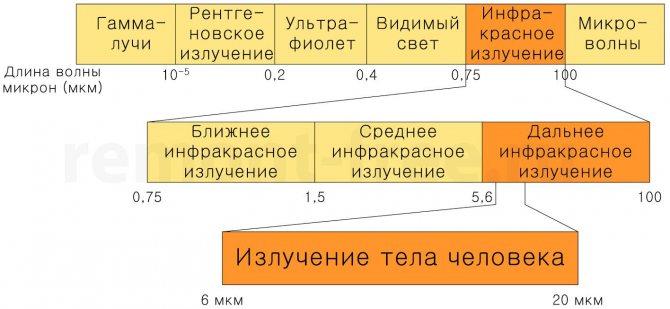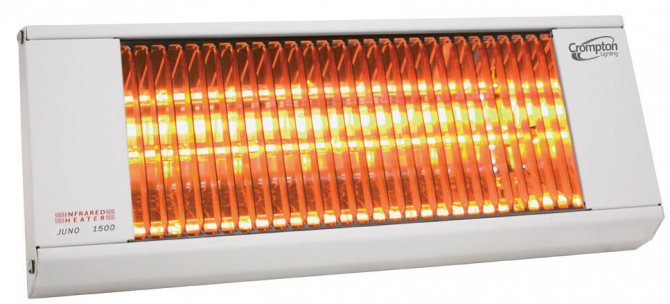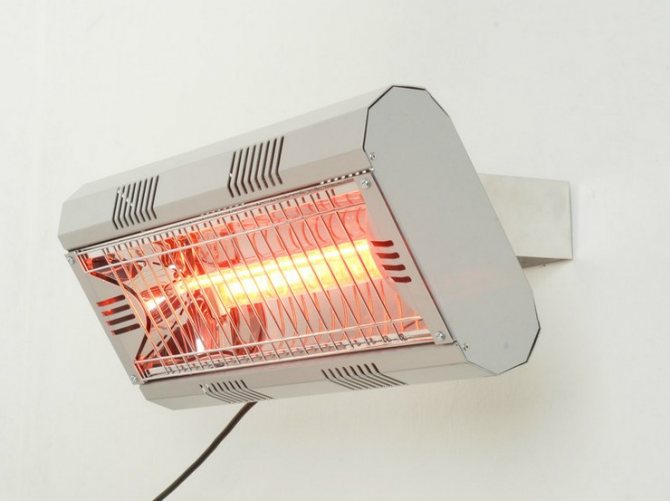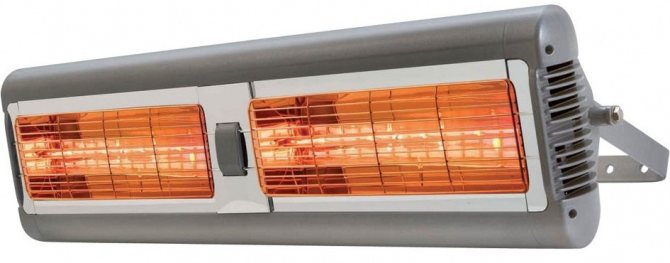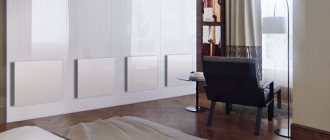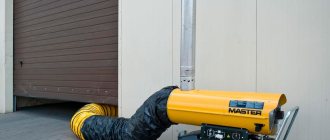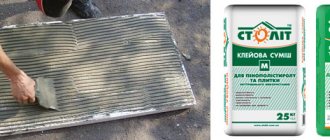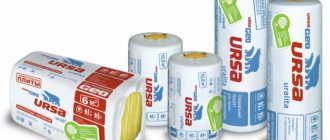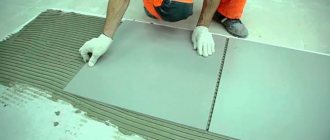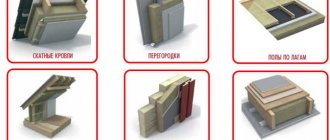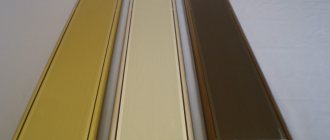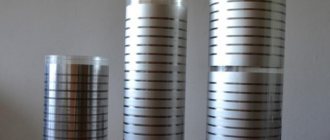An increase in the temperature in a room to maintain a certain level of comfort or a technologically required temperature regime is carried out using units of various designs called heaters.
Among the many types of heaters, there is a group of devices whose principle of operation is based on infrared (IR) radiation - waves generated by emitters heated with the help of some energy carrier (electricity, liquid or solid fuel, gas).
The group of IR heaters on electricity includes 3 types of devices that differ in the type of radiating element:
- halogen;
- quartz;
- carbon fiber.
Consider one of these devices - a halogen infrared heater.
Halogen heater device
The device of the heater depends on the principle of its operation - the method of generating and transferring heat to the environment.
Halogen heaters consist of an aesthetic safe design housing, in which, depending on the power of the device, one or more halogen lamps are installed. To give the radiation flux a concentrated directionality, the lamps in the housing are located against the background of a heat-resistant mirror reflector-reflector. The possibility of getting burns from accidental contact with the lamps is excluded by the protective mesh on the body in the direction of the radiation action.

Halogen heaters operate on a household power supply, are compact, lightweight, durable and popular in household use. Modern devices have a remote control option.
Halogen heater - warmth and comfort in the house
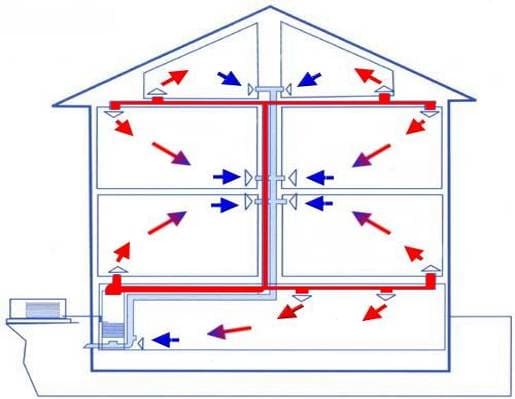

The most common way to create warmth and coziness in your home during cold times is to turn on the heater. There is a wide variety of models on the market. They differ in design and specifications. To make the right choice, you should study the principle of operation of the device, evaluate its advantages over other models.
Operating principle
The functions of the heating element are performed by a halogen lamp, which emits a stream of waves in the light and infrared range. Such a lamp is a round tube (tubular bulb) approximately 20-50 cm long, filled with halogen - a buffer gas (iodine or bromine), which does not allow the tungsten filament to burn out when heated from the passage of an electric current through it. When connected to the network, the spiral instantly heats up to glow, the tungsten atoms begin to detach from its surface, but in a halogen environment they do not settle on the walls of the tube, but return back to the spiral, increasing its temperature.
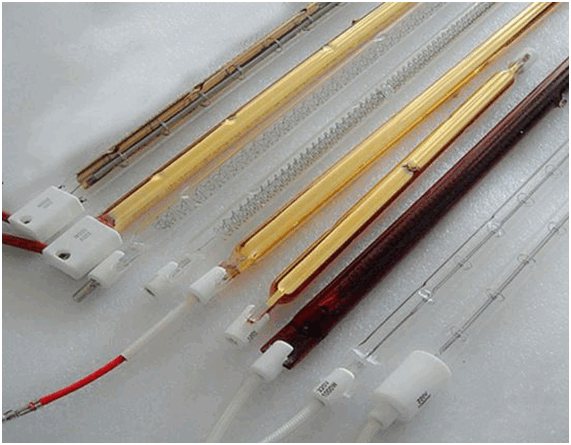

The flux of infrared radiation from the lamp, most often located horizontally in the housing, heats not the air in its path, but the objects it reaches. In this case, not only their surface heating occurs, but also internal heating, as a result of which the heated object begins to give off excess heat to the environment. Thus, the room warms up evenly, without the convection process from the heat source and the accumulation of dust on it. The power regulator allows you to set the desired value, and the low weight of the device allows you to move it as needed to other rooms and use it for both zonal (volumetric, diffuse) and local (subject-focused) heating.
An excessive increase in temperature in a closed room causes a decrease in the required value of air humidity, therefore, when using several halogen heating devices in the room at the same time, it is advisable to install a humidifier as well, which, if necessary, to maintain an elevated temperature, will provide optimal environmental humidity. Uniform humidification of the volume is ensured by turning on the ventilation function available in such devices.
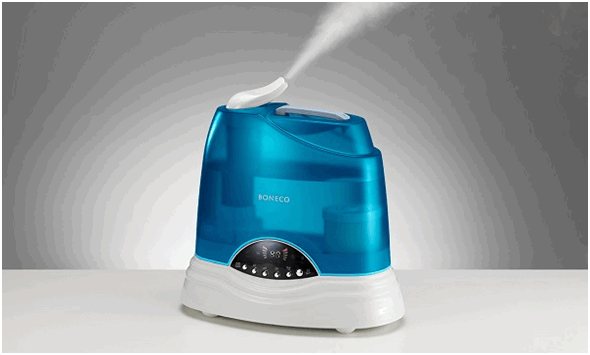

Pros of halogen heaters
- For halogen heaters high performance factor... The heat generated is twice that produced by the same oil heater. Heating wave up to 4 m, while in others, only 1 m.
- The heating element has no expiration date... It can be said to be eternal.
- Does not dry air or burn oxygen... Since it heats not air, but objects. And already they give off heat to the air.
- Automatic shutdown in case of voltage drop or surges in the network. This is very important when children are in the house and when they are running, they can catch on the heater.
- The most important thing is saving... Halogen heaters consume much less energy than conventional heaters.
- Noiselessness... The device will not interfere with its buzz if people are resting in the room.
- Is not a collection of dirtas it does not attract dust.
- Speedwith which you feel warm. The heater has enough time to heat up the room.
The principle of directed heat, makes it possible to use the heater on open air... It can be not only the terrace of a private house, but also an outdoor cafe. They are also useful for repairs. If you need to dry the plaster on the wall, but there is no heating, it is damp outside, then a directed flow of heat will dry the wall quickly.
Halogen systems are also in demand among farmers. They are placed in barns and chicken coops, in severe frosts. If the animal accidentally gets to it and knocks it down, the circuit will automatically open. In such premises, where there is a lot of hay and straw, this property will help to avoid a fire.
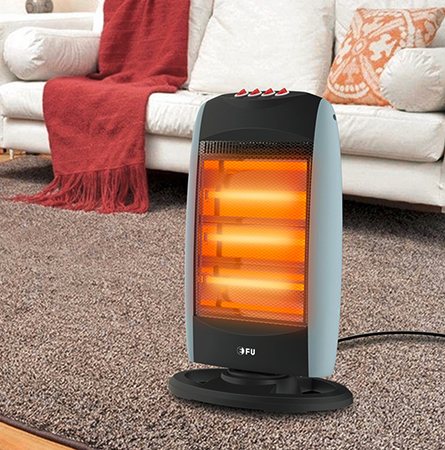

Types of halogen heaters
Halogen heaters are divided into:
- by destination:
- household - power up to 3 kW;
- industrial - power more than 3 kW;
- by execution:
- floor - the most common type, most often having wheels for ease of movement;
- wall-mounted - used in rooms of a small area and mounted at a height of approximately 1.5 m from the floor, while the base must be well insulated, made of heat-resistant materials;

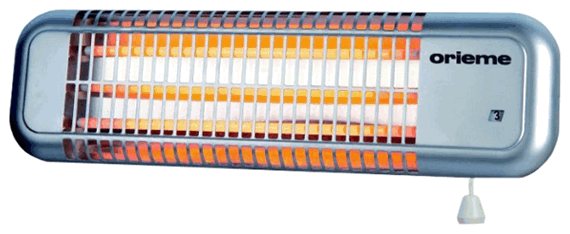
- ceiling - mounted with brackets to a regular ceiling base or having the ability to be installed in a suspended ceiling structure, take up a minimum of space, installation is advisable for a ceiling height of 3.0 m, heat-resistant thermal insulation of the base is mandatory.

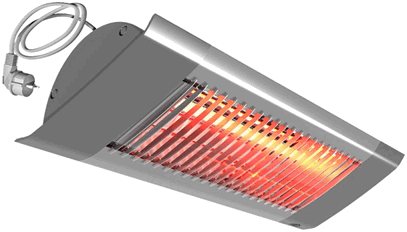
Pros and cons
Infrared heaters are widely used both for heating the room as a whole, and as an auxiliary heating device, so to speak, to help with the main heating system.
Positive properties of infrared heaters:
- practicality and reliability in operation;
- long service life;
- has a high degree of heating;
- safe to use;
- effective for heating indoor and outdoor premises for various purposes (residential buildings, verandas, outdoor gazebos, Finnish saunas, etc.);
- the possibility of spot heating and zone heating;
- operation is possible in conjunction with a device that maintains a constant temperature level;
- creates the effect of warm floors.
Negative characteristics of infrared heaters:
- stationary installation system;
- operation requires a certain ceiling height in the room;
- relative ease of management due to the low level of functionality;
- overheating during continuous and long-term operation.
Heater requirements
When choosing a halogen heater, you must be guided by the following requirements:
- required power - for heating an area of 10 square meters. in ideal conditions (no drafts, thermal insulation of the room), 1 kW of heating device power is required, therefore, based on the need for 1.3 kW per 10 square meters;
- installation reliability - depending on the condition of the walls and ceilings, their bearing capacity and the possibility of ensuring safe operation, the heater version is selected (floor, wall or ceiling);
- outdoor safety - the heater body must be functional, that is, not only have an aesthetic design, but also exclude the possibility of burns and electrical injuries - have a reliable (ceramic, basalt) insulator and grounding device inside;
- safety of the internal device - a modern heater must be equipped with an overheating protection sensor, which will extend the life of the heater and prevent ignition of the device itself (paintwork, wiring, toggle switches) or surrounding objects;
- reliability of the manufacturer - when buying, you should give preference to products of well-known and trusted manufacturers, since the purchase of heating devices of low quality and dubious production threatens not only with its quick failure, but also with the danger of injury or fire.
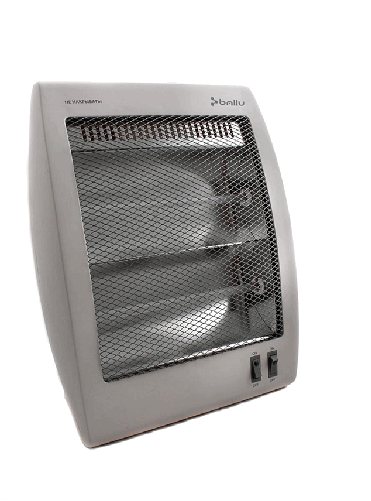

Heating element types
Panel with metal thread inside. Such panels are used only in flat infrared heaters, both wall and ceiling. They are not used in floor-standing devices.
Halogen lamps... The main advantage is the low price. Disadvantages: they glow during work and, most importantly, emit short waves that are harmful to human health. Therefore, it is recommended to use them for a short time and in the absence of people in the room.
Carbon heating element... It is a closed quartz tube with a carbon (carbon) spiral inside it. The advantage of such heaters is their high efficiency, they heat up quickly. The disadvantages include a relatively low service life - about two years and a reddish glow that is unpleasant for the eyes.
Heating element with ceramic sheath has good protection, so there is no glow during its operation. Such heaters work for at least three years. It is more economical as the power consumption can be adjusted from 50 to 2000 watts. Disadvantages - higher price, slow warm-up.
Tubular (micathermic) metal element structurally resembles ceramic, but it has a higher price. They are characterized by high reliability and long service life. The main disadvantage is crackling when heated, which is associated with the expansion of the metal.
Before choosing, you need to decide on several questions:
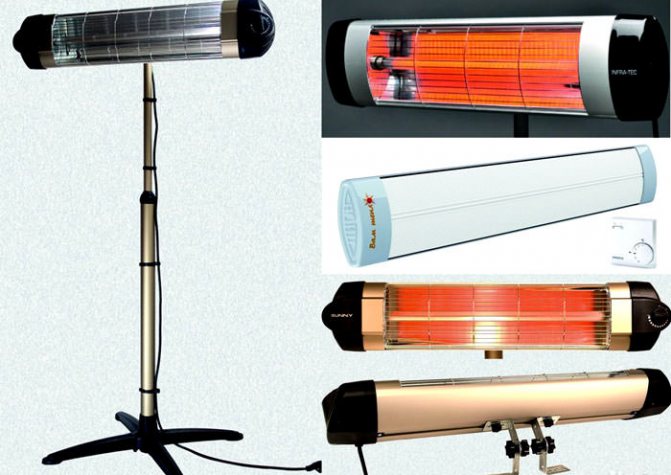

- What is planned to heat the room - residential or not;
- Will this be the main source of heating or an additional one; if the main one, then what area is required to be heated and, based on this, calculate the required power. The power is calculated simply: 100 W per 1 m² of area, plus 10% of the headroom. This method is suitable for rooms with a ceiling height of no more than 3.5 m. The second method, which is suitable for any room, is to divide the volume of the room by 30.
- Heaters can be portable and stationary. In the latter case, it is necessary to make a choice between ceiling, wall and "warm floor".
Gas appliances usually used for heating non-residential premises. Their main advantage is that they are more economical. Gas heaters are of direct and indirect heating:
- In the first case, air is used for combustion, which is located directly in the room, and combustion products are emitted there., therefore, heaters of this type can only be used in a well-ventilated area;
- Indirectly heated gas heaters use a special system to remove combustion products outside the room. The assembly of such a system is quite complex and requires a professional approach.
Electric heaters are used for residential premises.
Ceiling have a number of advantages: they do not require maintenance and do not clutter up the room, they allow you to warm up any, even hard-to-reach areas. A wide range of models allows you to choose a heater for any interior. Typically, the kit includes a remote control and a thermostat (to maintain the set temperature).
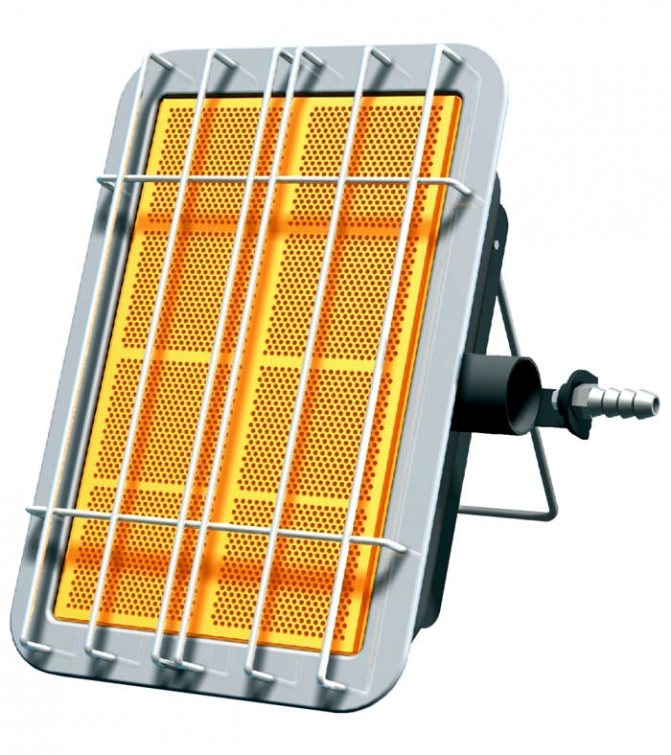

Gas infrared heater of Russian production
They are produced either in the form of panels - for armstrong ceilings (cost - from 2000 rubles), or suspended, on brackets (from 1800 rubles). If you have to equip a room with low (up to 3.5 m) ceilings, it is recommended to take not one powerful, but several with low power - so that they can be more evenly distributed.
These heaters can be equipped with different heating elements. The most durable - emitters made of metal (price - from 3000 rubles), preferably from anodized aluminum; but the best option is glass (from 5000 rubles). Metal emitters can crackle during operation, which is associated with the expansion of the metal; glass does not have this drawback.
Separately, it should be noted film heaters, in which carbon thermoelements are used as a source of infrared radiation. The "warm ceiling" system is mounted from such films: the film evenly "rolls out" along the ceiling and then hides behind the ceiling trim. This ensures uniform heating of the entire room.
The rays emitted by the film are directed downward, i.e. heat up the floor and furniture, the heat from which rises up. The only drawback of such a system is that household appliances are exposed to radiation, which can sometimes negatively affect its operation. Film cost - 225 rubles. per sq.m.
The same film is used for the "warm floor" option, in which case it is mounted under the floor covering. The coating can be any, up to a cement screed. With this option, uniform heating is achieved without any impact on the technique.
But there is an important caveat: despite the fact that when assembling a "warm floor" it is envisaged to use a special protective film, it is not recommended to mount it under heavy objects constantly standing in one place, since these areas will overheat and quickly fail. The cost of the film is the same as in the “warm ceiling” option (225 rubles per sq.m.), but there will also be additional costs for the protective film and special fasteners - about the same amount.
Wall the option cannot provide uniform heating of the entire room, but it is effective as an additional source of heat in certain areas. Execution - either in the form of panels (1500 rubles), or film (960 rubles) The latter, as a rule, is performed in the form of a panel, which allows you to decorate the interior.
Floor standing stationary infrared heaters are not available. Heavy machines are equipped with casters, small heaters have carrying handles. Almost all models include an overheating protection system and a roll-over shutdown sensor. Additional functions are possible, such as a remote control or a humidifier.
When choosing floor radiators, in addition to design, one should be guided by the heating element (see the beginning), i.e. remember that:
- Halogen - cheap (from 600 rubles), but harmful, should be used for short-term switching on and, preferably, not directed at people;
- Quartz and carbon - the price is higher (from 1200 rubles), but the radiation is "healthy", of the shortcomings - they glow red and last about 2 years;
- Ceramic - more expensive than carbon ones (1,500 rubles), but this is justified: the service life is more than 3 years, they are more economical in operation; of the disadvantages - long heating;
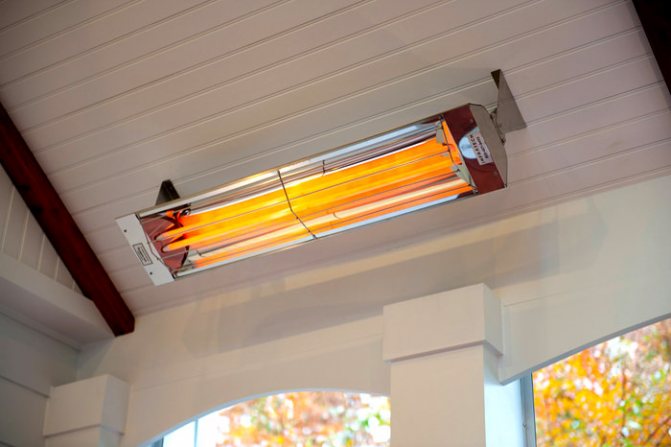

Ceiling infrared heater
Terms of use
The simplest day-to-day care of ceiling-type halogen devices is that they are inaccessible to mechanical damage and children, therefore, they only need to be kept clean.
Wall and floor models must be located at a distance of at least 1 m from surrounding objects; it is strictly forbidden to place any objects on the heaters for drying or heating. In addition, it is also forbidden to cover the heating devices with anything, as this can lead to ignition of the coating, getting a thermal burn from contact with it or overheating of the device.
Do not stay under the influence of the radiation flux in the immediate vicinity of the heater for a long time - you can get burned. In addition, the radiation from halogen lamps is shortwave, and prolonged human exposure is undesirable.
Important! If the area of the heated room is significant, then the use of several low-power halogen heaters will be optimal to ensure a comfortable temperature regime in the room, since the use of one device of total power has more negative factors.
It is advisable to purchase a halogen heater with lamps that have a special coating that weakens their glow when heated.
Varieties of devices
Modern halogen devices are usually divided into several main categories:
- Household. The power reaches 3 kW.
- Execution type.
- Industrial. The standard power rating starts from 4 kW or more.
- Purpose.
- Ceiling. They are fixed with powerful brackets to a standard ceiling base. If possible, then the installation is carried out in a special structure of the suspended canvas. Thanks to this, the equipment takes up a minimum of free space. This option is only appropriate if the ceiling height is 3 meters or more. It is imperative for the user to construct a reliable heat-resistant heat-insulating base.
- Wall mounted. Used in small spaces. Installation is carried out at a height of at least 1.5 m from the floor. It is necessary to provide high-quality thermal insulation of the base.
- Outdoor. This is the most requested option. Many devices are sold with small wheels for comfortable movement.
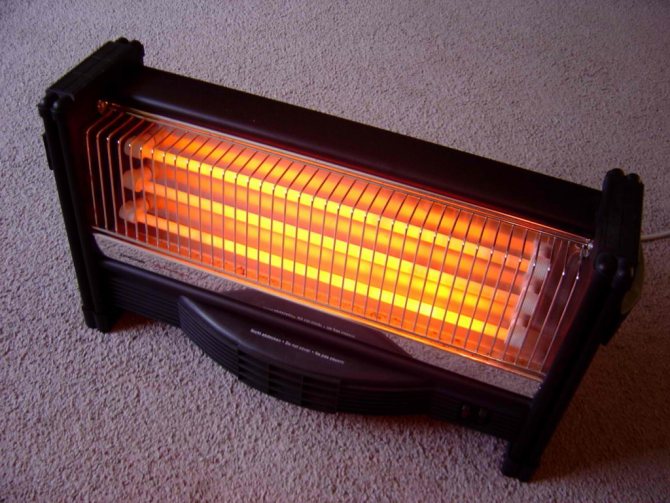

High power floor unit
Advantages and disadvantages
IR heaters based on halogen lamps, like all other heating devices, have their advantages and disadvantages.
Let's list the advantages:
- high speed of achieving the effect - the effect of the device is felt within a few minutes after switching on;
- quiet operation - in the absence of a ventilation function, the heater is absolutely silent;
- uniformity of room heating - no convection and dust accumulation;
- compactness of devices and their relatively low weight;
- the ability to use in the fresh air and in a draft;
- affordable price range.
The disadvantages of a halogen heater are much less, but it is still better to know about them, so we list them:
- undesirability of prolonged exposure to short-wave radiation of halogen lamps on the human body;
- glow of lamps during operation.
The list of characteristics of a halogen infrared heater with the specification of its advantages and disadvantages allows one to assess the effectiveness and feasibility of its use in domestic conditions in comparison with other heating devices.
Varieties for home use
All heaters can be conditionally divided into two groups: light and long-wave.
The characteristic features of the first type are:
- high temperature of the emitter surface (up to 600 ° С);
- the ability to heat several rooms.
The second group is less effective, so they are often used to heat small rooms or greenhouses. An example is the Ballu infrared heater. Reviews about this device are mostly positive. Users say that it is inexpensive, safe, economical, heats up quickly, and has aesthetic appearance.
Operational safety
Like any device that uses electricity for operation, a halogen heater requires safety precautions during operation. Some of them have already been mentioned above, but it is better to bring them together under one heading in the form of a separate list of conditions that must be met:
- the housing of the halogen device must be grounded;
- the minimum distance from the device to the nearest object should be 1 m;
- it is forbidden to leave the device turned on overnight, cover the heater with anything or place objects on it for drying;

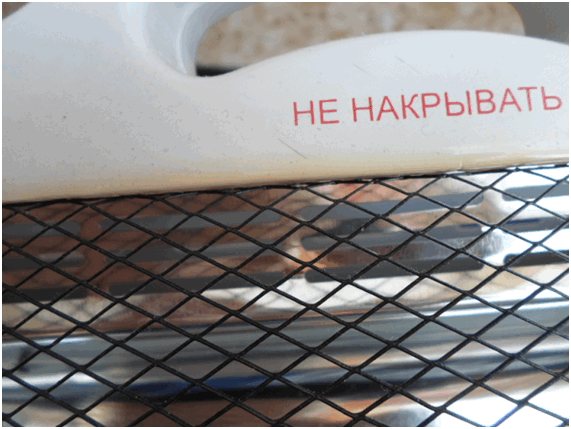
- avoid the simultaneous inclusion of several powerful halogen devices in order to avoid overloading the power supply;
- the concentrated directivity of the radiation of halogen lamps on a person from a short distance can lead to burns;
- when installing a wall-mounted halogen heater, the base must be insulated with a heat-resistant material;
- the radiation lamps must be kept clean, since the dust accumulated on them is dangerous for fire when the device is turned on;
- Operation of the halogen heater without a protective front mesh is prohibited.

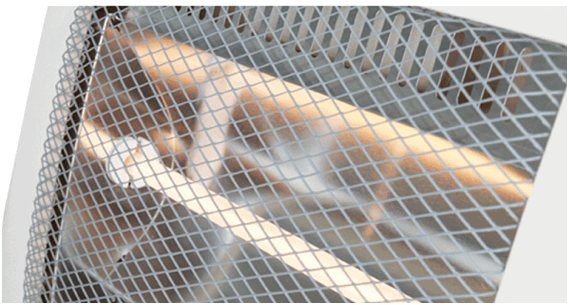
Manufacturers and models - which one is better to buy
For home, you can choose a device from the following manufacturers:
- De'Longhi - provides fast heating and multiple programs. Slim and compact, they feature a double tube that helps increase productivity by allowing you to heat your room quickly and easily. De'Longhi has an impressive power range along with an adjustable thermostat - so you can select your desired temperature with a simple control panel. The 24-hour timer allows you to program the switch-on time.
- Dimplex Is one of the leading brands to look out for in the portable heater market. Offers high performance and affordable prices. The Dimplex typically has multiple functions, including heating, cooling, freeze settings, and safety shutdown. This means that if the device overheats, it will turn off. As far as his work is concerned, he is not too loud.
Overall, a well-priced device coupled with a three-year warranty should be a good helper during the winter.
Useful articles, news and reviews on our Yandex Zen channel
Subscribe to
DIY halogen heater
If you wish, you can make a heater from halogen lamps with your own hands. To do this, you need to prepare a suitable container, the dimensions of which are within 40 * 60 cm (for example, a paint can). The container is cleaned and dried. A brick and a halogen lamp are installed inside the can, which heats up to 40-50 degrees during light emission. The wires coming from the lamp are led out. From above, the structure is covered with a metal box, in which there is no bottom.
Important! A jar with a halogen lamp must be installed on the legs, which will make it possible to prevent overheating of the floor surface.
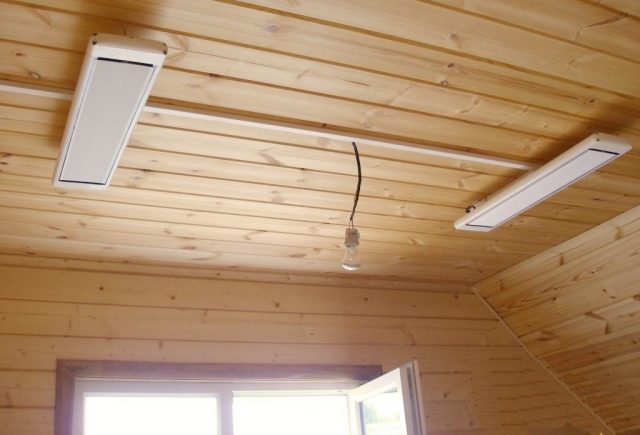

Halogen heaters are safe, so they can be used even in wooden houses
Features of operation
Ceiling models are easy to maintain and only need to be kept clean. It is recommended to install a floor-standing or wall-mounted device at a distance of 120-150 cm from the floor surface and other objects. Things should not be allowed to be on the heater, which will make it possible to prevent a fire. It is also prohibited to cover the heater with a curtain or tulle. It is better not to touch a functioning device with your hands so as not to get a thermal burn of the skin. Every 5-7 days, you should clean the halogen device from dust.
Important! Halogen home heaters are capable of emitting short wavelengths of light that have a negative effect on the human body. That is why it is not recommended to use the device for a long period of time.

